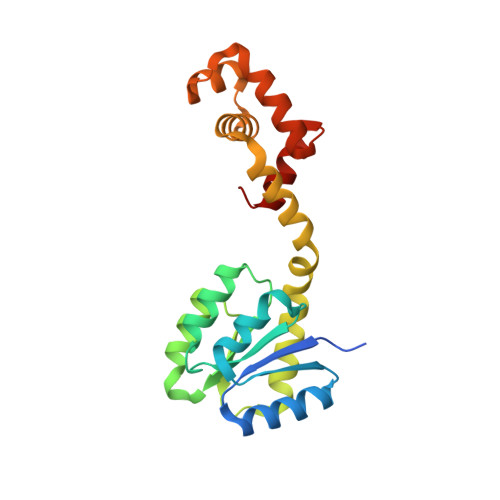Architecture of the complete oxygen-sensing FixL-FixJ two-component signal transduction system.
Wright, G.S.A., Saeki, A., Hikima, T., Nishizono, Y., Hisano, T., Kamaya, M., Nukina, K., Nishitani, H., Nakamura, H., Yamamoto, M., Antonyuk, S.V., Hasnain, S.S., Shiro, Y., Sawai, H.(2018) Sci Signal 11
- PubMed: 29636388
- DOI: https://doi.org/10.1126/scisignal.aaq0825
- Primary Citation of Related Structures:
5XSO, 5XT2 - PubMed Abstract:
The symbiotic nitrogen-fixing bacterium Bradyrhizobium japonicum is critical to the agro-industrial production of soybean because it enables the production of high yields of soybeans with little use of nitrogenous fertilizers. The FixL and FixJ two-component system (TCS) of this bacterium ensures that nitrogen fixation is only stimulated under conditions of low oxygen. When it is not bound to oxygen, the histidine kinase FixL undergoes autophosphorylation and transfers phosphate from adenosine triphosphate (ATP) to the response regulator FixJ, which, in turn, stimulates the expression of genes required for nitrogen fixation. We purified full-length B. japonicum FixL and FixJ proteins and defined their structures individually and in complex using small-angle x-ray scattering, crystallographic, and in silico modeling techniques. Comparison of active and inactive forms of FixL suggests that intramolecular signal transduction is driven by local changes in the sensor domain and in the coiled-coil region connecting the sensor and histidine kinase domains. We also found that FixJ exhibits conformational plasticity not only in the monomeric state but also in tetrameric complexes with FixL during phosphotransfer. This structural characterization of a complete TCS contributes both a mechanistic and evolutionary understanding to TCS signal relay, specifically in the context of the control of nitrogen fixation in root nodules.
Organizational Affiliation:
Molecular Biophysics Group, Institute of Integrative Biology, Faculty of Health and Life Sciences, University of Liverpool, Liverpool L69 7ZB, UK.
















